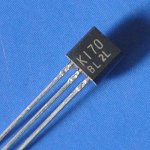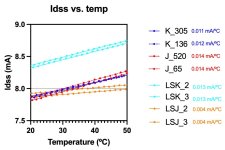in my humble opinion, it could make more sense to put the Toshiba and Linear jfet in typical NP amplifiers, preamplifiers, buffers and compare what kind difference they could have.
Maybe someone has done it?
Maybe someone has done it?
answer to wwwtttwww
I used the original TOSHIBA 2SK170 (BL) /2SJ74 (BL) and the
LINEAR SYSTEMS LSJ74 (BL) / LSK170 (BL)
in a few of my PASS AMPS. All with very good results.
I have built two BA- Poweramps (BA-3 frontend / BA-complementary output/bias boards). One has the TOSHIBA - JFets on input, the other AMP the
LINEAR SYSTEMS JFets. All have been bought matched! The MOSFETs are
FAIRCHILD FQP 3P20 /3N30 (with the 1kohm trimpots at P1/P2)
Sonically for me no real difference. But the BA-3 FE offers trimpots on the pcb to adjust smaller offsets. And you will need your time to adjust the offset
at the output. 😀 Patience
And I build a BA-3 Preamp with only TOSHIBA 2SK170/2SJ74 (BL grade) and TOSHIBA 2SJ313 /2SK2013. Oversized PSU with regulators.
Very nice preamp!!
My experience.
Greets
Dirk
I used the original TOSHIBA 2SK170 (BL) /2SJ74 (BL) and the
LINEAR SYSTEMS LSJ74 (BL) / LSK170 (BL)
in a few of my PASS AMPS. All with very good results.
I have built two BA- Poweramps (BA-3 frontend / BA-complementary output/bias boards). One has the TOSHIBA - JFets on input, the other AMP the
LINEAR SYSTEMS JFets. All have been bought matched! The MOSFETs are
FAIRCHILD FQP 3P20 /3N30 (with the 1kohm trimpots at P1/P2)
Sonically for me no real difference. But the BA-3 FE offers trimpots on the pcb to adjust smaller offsets. And you will need your time to adjust the offset
at the output. 😀 Patience
And I build a BA-3 Preamp with only TOSHIBA 2SK170/2SJ74 (BL grade) and TOSHIBA 2SJ313 /2SK2013. Oversized PSU with regulators.
Very nice preamp!!
My experience.
Greets
Dirk
How about this.... 100 PCS 2SK170-BL TO-92 K170-BL Low Noise Audio Amplifier Applications | eBay
100 peaces 2sk170 for 12 dollar.....
100 peaces 2sk170 for 12 dollar.....
I published a while ago some matching data on LSK170/LSJ74 JFETs.
These are being hailed as worthy equivalent of the Toshiba 2SK170/2SJ74.
https://www.diyaudio.com/community/...lsk170-jfet-pairs-grade-b.321649/post-5706027
Yesterday, I was playing with a complementary pair of the LS JFETs.
To my great surprise, totally unexpected results as follows :
The pair is wired as a simple complementary source follower with no source resistance.
They were matched to better than 0.1mA Idss at +/-12V individually beforehand.
In the source follower circuit, if the Idss is perfectly matched, output DC should be 0V.
Here are the measurement results :
Supply DC_offset
+/-12V -0.9mV
+/-9V_ -6.4mV
+/-7V_ -10.6mV
Idss of both JFETs drop with Vds, but the NJFET a lot more than the PJFET.
This means that in many applications, a pair matched at 12V rails are unuseable at even 9V rails !!!
How does Toshiba compare ?
I picked a matched pair from my private collection, with Idss at 8.05mA and matched at +/-9V to 0.02mA.
Supply DC_offset
+/-12V 0.8mV
+/-9V_ 0.0mV
+/-7V_ -0.6mV
So when to using LSK/LSJ matched pairs, make sure that the matching conditions is the same as in the application.
Unless you are happy with 10mV DC offset. 😉
Patrick
These are being hailed as worthy equivalent of the Toshiba 2SK170/2SJ74.
https://www.diyaudio.com/community/...lsk170-jfet-pairs-grade-b.321649/post-5706027
Yesterday, I was playing with a complementary pair of the LS JFETs.
To my great surprise, totally unexpected results as follows :
The pair is wired as a simple complementary source follower with no source resistance.
They were matched to better than 0.1mA Idss at +/-12V individually beforehand.
In the source follower circuit, if the Idss is perfectly matched, output DC should be 0V.
Here are the measurement results :
Supply DC_offset
+/-12V -0.9mV
+/-9V_ -6.4mV
+/-7V_ -10.6mV
Idss of both JFETs drop with Vds, but the NJFET a lot more than the PJFET.
This means that in many applications, a pair matched at 12V rails are unuseable at even 9V rails !!!
How does Toshiba compare ?
I picked a matched pair from my private collection, with Idss at 8.05mA and matched at +/-9V to 0.02mA.
Supply DC_offset
+/-12V 0.8mV
+/-9V_ 0.0mV
+/-7V_ -0.6mV
So when to using LSK/LSJ matched pairs, make sure that the matching conditions is the same as in the application.
Unless you are happy with 10mV DC offset. 😉
Patrick
Are you sure? I measured Idss vs. Vds for two samples of Toshiba and Linear Systems K170 and J74 JFETs and I find that Idss increases with Vds. Between the four types of JFETs the Linear Systems K170 indeed stands out with an almost 3-fold increased Vds dependency.Idss of both JFETs drop with Vds, but the NJFET a lot more than the PJFET.
You are trying to correct my English, I guess ? 🤓
I meant Idss of both JFETs drop with dropping Vds.
(Did not say increasing Vds, did I ?)
In any case, our results colerates, and I will avoid LS parts.
Patrick
I meant Idss of both JFETs drop with dropping Vds.
(Did not say increasing Vds, did I ?)
In any case, our results colerates, and I will avoid LS parts.
Patrick
From China, you can get them from me for free, but mayby its only a peace of plastic....How about this.... 100 PCS 2SK170-BL TO-92 K170-BL Low Noise Audio Amplifier Applications | eBay
100 peaces 2sk170 for 12 dollar.....
Not trying to correct anything - and I did miss the 'dropping' part of your sentence, so my wrong.
Quite interesting also the (relative) temperature behaviour of these JFETs. Attached is plot of Idss vs. temp for these FETs. This time the LSJ 74 stands out, but for a flat response.....
Did not normalise these data yet
Quite interesting also the (relative) temperature behaviour of these JFETs. Attached is plot of Idss vs. temp for these FETs. This time the LSJ 74 stands out, but for a flat response.....
Did not normalise these data yet
Attachments
But the Toshiba's have almost identical tempco.
Hence they track each other.
Also tempco depends greatly on Idss, Yfs, etc.
As mentioned in Borbely's legendary article on JFETs.
https://audioxpress.com/article/JFETs-The-New-Frontier-Part-1
You can calculate the zero tempco point with the following formula:

Patrick
Hence they track each other.
Also tempco depends greatly on Idss, Yfs, etc.
As mentioned in Borbely's legendary article on JFETs.
https://audioxpress.com/article/JFETs-The-New-Frontier-Part-1
You can calculate the zero tempco point with the following formula:
Patrick
Last edited:
I'm doing these measurements as quality control on a lot of degeneration matched NNPP-sets I'm sorting out and the LS FETs were measured just because I happened to stumble upon them in the same drawer 😉
I'm indeed happy to see that matched (Idss and Yfs) Toshibas track nicely largely independent of Vds and temperature.
Can't say the same for the (few) LS samples in my hands.
I'm indeed happy to see that matched (Idss and Yfs) Toshibas track nicely largely independent of Vds and temperature.
Can't say the same for the (few) LS samples in my hands.
I have enough LS JFETs to confirm that your measurements are quite typical.
The LS only sit in my drawer.
Won't be used; maybe only for high-rise experiments.
Patrick
The LS only sit in my drawer.
Won't be used; maybe only for high-rise experiments.
Patrick
- Home
- Amplifiers
- Pass Labs
- Linear Systems Matched LSJ74/LSK170 JFET pairs (Grade B)









